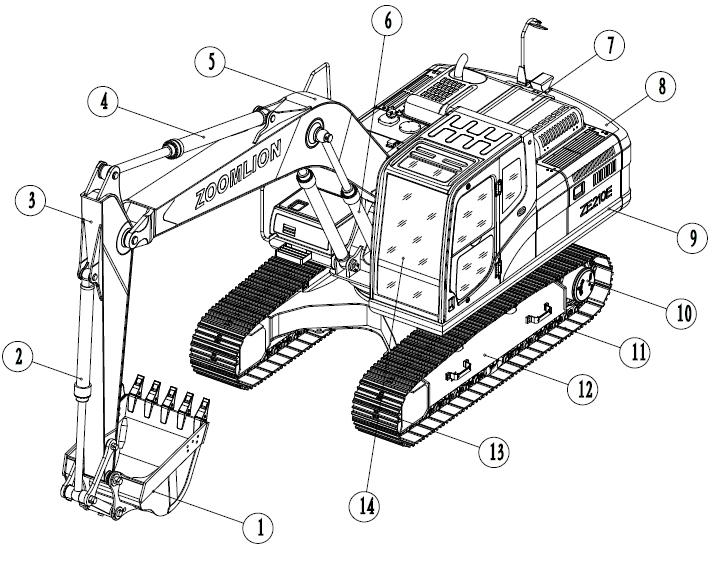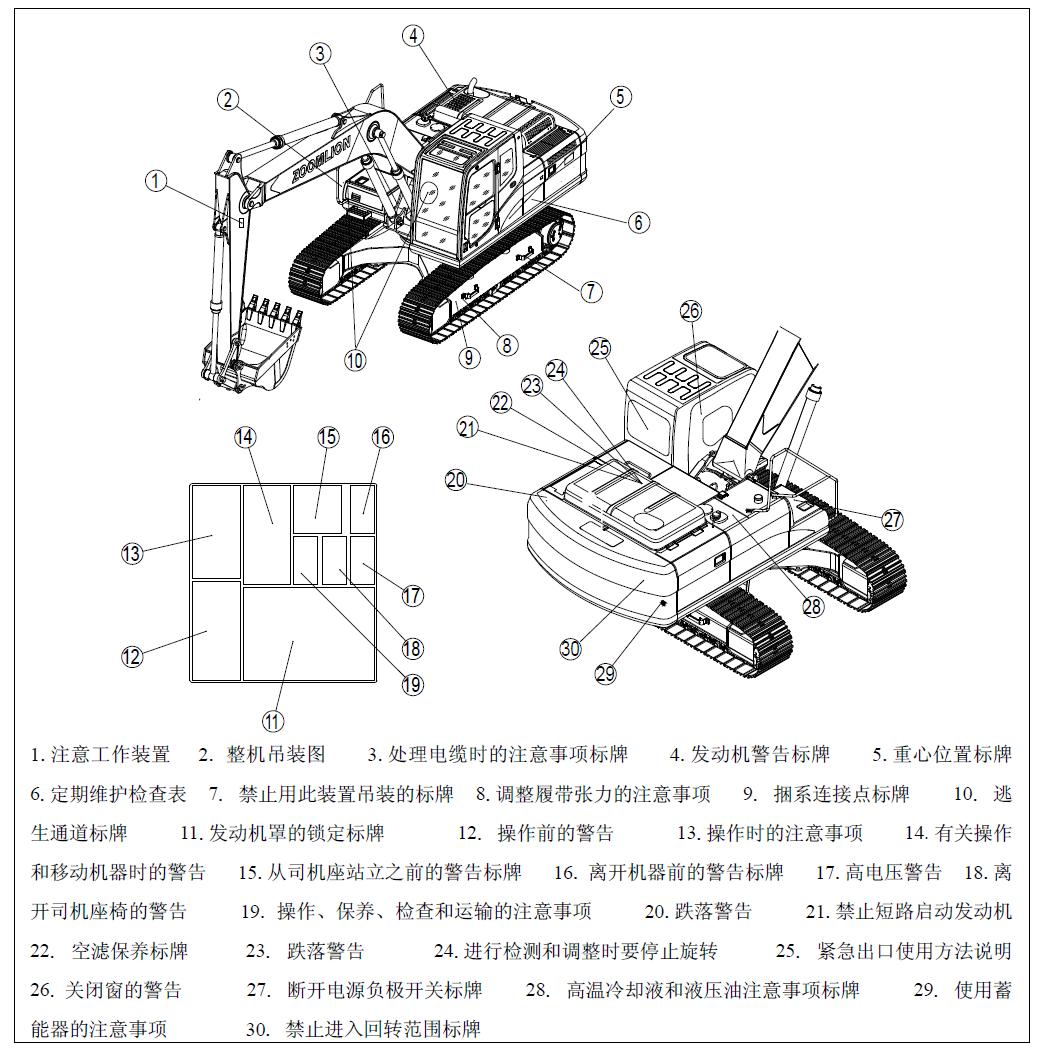
26 minute read
ZE205E/ZE230E OPERATION MANUAL
To users
Dear users, thank you for choosing Zoomlion hydraulic excavator. Before using this machine, please read and fully understand this manual and strictly comply with the relevant provisions in it.
This manual gives detailed information on safety instruction, important technical parameters, and safe operation related to hydraulic excavator, aiming at instructing users for safe operation of hydraulic excavator and fully achieving the efficiency of the machine in the operating process. Please keep this operating manual for future reference
Do not attempt the operation and maintenance of products before you have read and understood the operation manual. If there are any ambiguities or questions, please call your local service engineer, and we will provide you with timely and effective technical support. The company will not be liable for any adverse consequences arising from not following this manual.
The operation manual is an integral and important part of the product, so be sure to transfer this manual to the assignee along with the transfer of the machine. The operating manual is under the protection of intellectual property, so do not copy or use it for other purposes without permission.
Due to the continuous improvement and upgrades of product design as well as difference in the specifications and models of products, the details of some of the pictures and text in this manual may be different from your products. If in doubt, please call the local service engineer.
The Company reserves the right to amend the content of the “Operation Manual” due to technical improvements, the content of the manual is subject to change without notice Herewith we beg your sincere understanding.
This operation manual is suitable for ZE205E/ZE230E hydraulic excavators
Thank you for your trust and support to Zoomlion’s products, and we sincerely wish you all the best.
Safety Instructions
The manual involves the following safety and warning icons:
Danger
Warning
Attention
Caution
Prompt
Important
High risk of danger: there is risk of death or heavy injuries
Middle risk of danger: there is risk of heavy injuries
Slight risk of danger: there is risk of light injuries or moderate injuries
Safety sign: there is risk of property loss
This icon marks instructions for particular information.
The icon is for showing the importance of particular information.
It shows that this operation does not conform to the safety specification and easily causes death and injuries, so it is forbidden.
ZE205E/ZE230E HYDRAULIC EXCAVATOR
Operation Manual
Chapter One: Safety criterion for excavator
Chapter One: Safety criterion for excavator
1.1 Safety signs
1.1.1 Location of safety signs
This machine uses the following warning signs and safety signs (as shown in Figure 1-1, Note: The figures inside the circle are the illustrations corresponding to the figures inside brackets in the "safety signs" text. For example: ○ 1 → (1)). It is necessary to remind that they should be kept in correct place and always be kept clean to ensure that the signage content can be clearly read. When cleaning the signs, do not use organic solvents or gasoline, otherwise it would peel off the sign. If some of the signs are damaged, lost or can not read normally, they should be replaced timely. See instructions or actual signs for details about the part number of the signs, and make the order from Zoomlion, or Zoomlion dealers.
1.1.2 Safety signs
(1) Precautions about working device, as shown in Figure 1-2.

1. The sign shows the possibility of collision hazard by the working device.


2. Keep away from the machine’s working device at a safe distance.
(2) Whole machine lifting figures, as shown in
(3) Precautions on cable handling, as shown in
1. The sign says that there is a risk of electric shock when handling the cable
2. Please note that read the instructions carefully and handle the cable safely and correctly.
This sign indicates to notice that there is a danger to be hurt by the high temperature or the fan blades when the engine was just started or shut down


Warning Prompt


(7) Sign for prohibiting hoisting with the device, as shown in Figure 1-8


Danger
The sign indicates prohibition for hoisting with this device
(8) Precautions on adjusting the track tension, as shown in Figure 1-9
Prompt
1. The sign says that there is risk of injury if plug flies out from the track tensioner.
2 For safe and proper adjustment of the tracks, please read the instructions.
(9) Tie point sign, as shown in Figure 1-10
Prompt
The sign indicates bundle device can be installed here to fix the machine so that the machine is stable and to avoid the machine sway during the transportation
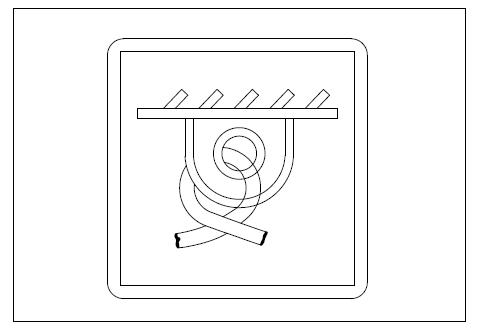
(10) Escape hatch, as shown in Figure 1-11
Important
The sign indicates to escape along with the direction of the arrow to keep personal safety.
(11) Engine hood lock sign, as shown in Figure 1-12.


Prompt
1. This sign indicates to lift the handle to make sure the hood was locked firmly after covering the engine hood.
2. Please read the operation manual and maintenance manual carefully and comply with the provisions strictly.
(12) Warning before operation, as shown in Figure 1-13.
Warning
1. The signal indicates that please keep in mind the followings before moving or operating machine in case of any heavy injuries or even death.
2. Please blow the horn to notify people nearby.
3. Please make sure that there are no people above, around the machine or in the rotation area of the machine.

4. Please rotate the upper body to ensure the clear vision for driving forward if necessary.
5. Please have surveillance at places of weak vision.
Please keep in mind the followings before moving or operating the machine in case of any heavy injuries or even death.
*Please blow the horn to notify people nearby.
*Please make sure that there are no people above or around the machine or in the rotation area of the machine.
*Please slew the superstructure to ensure the clear vision for driving forward if necessary.
*Please have surveillance at places of weak vision.
Besides the above, please also follow the driving rules and mount rear view mirror.
(13) Precautions during operation, as shown in Figure 1-14.
Attention
1. The sign indicates that, in order to meet the needs of safety operation, please refer to the instruction about the standard operation and daily maintenance.

2. Please select the working mode that matching the work.
3. Starting and ending of the operation must be in accordance to the instructions, sufficient idle operation is necessary.
4. Raise one side of the body with the upper and lower arms supporting the ground. Do not work under the machine body.
5. When the vehicle is parked inclined, make sure the bucket end is located at the ground, and securely stop the track shoe.
6. Do not install or disassemble the machine with lifting jack theory.
7. Do not hit the machine while operating the boom, arm and bucket.
Attention
1. For safe operation, please refer to the instruction about the standard operation and daily maintenance

2. Please select the working mode that matches the work, so as to carry out easier and more efficient operation.
3. Starting and stopping of the operation must be in accordance to the instructions: sufficient idle operation is necessary
4. When raising one side of the body with the upper and lower arms supporting the ground, do not work under the machine body.
5. When the vehicle is parked and inclined, make sure the bucket end is located at the ground and securely stop the track shoe is secured.
6. Do not install or disassemble the machine with lifting jack theory.
7. Do not crash the body while operating the upper and lower arms, be specially carefully when working near the cab.
(14)
Warning
In order to prevent injuries or deaths caused by operation mistakes, before operating the machine, please confirm the condition of the machine and the displayed operation mode. Pay attention to the surrounding areas while confirming and do the operation slowly.
Warning
In order to prevent injuries or deaths caused by operation mistakes, before operating the machine, please confirm the condition of the machine and the displayed operation mode. Pay attention to the surrounding areas while confirming and do the operation slowly.
ISO specifications
Warning
When you want to stand up from the driver seat or to open or close the front window, or skylight or remove the window, make sure to turn the safety lock to the locked position. Any accidental touch of the operation lever may suddenly start the machinery, which may cause serious safety hazard.
Warning
When you want to stand up from the driver seat or to open or close the front window, or skylight, or remove the window, make sure to turn the safety lock to the locked position. Any accidental touch of the operation lever may suddenly start the machinery, which may cause serious safety hazard.
Attention
Make sure that the locking lever is locked before leaving the machine
Warning
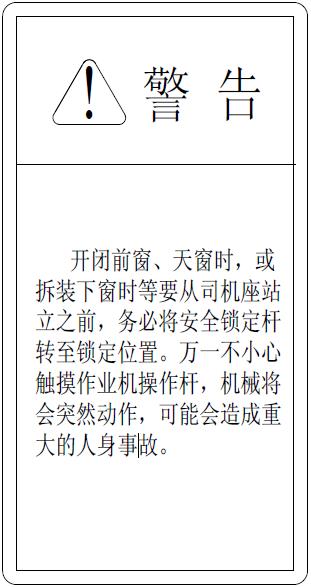
Make sure that the safety locking lever is locked before leaving the machine.

(17) High-voltage warning, as shown in Figure 1-18.
1. The sign says that there is a risk of electric shock if the machine is too close to the power lines.
2. Keep away from the power line for certain distance.
(18) Warning on leaving the operator seat, as shown in Figure
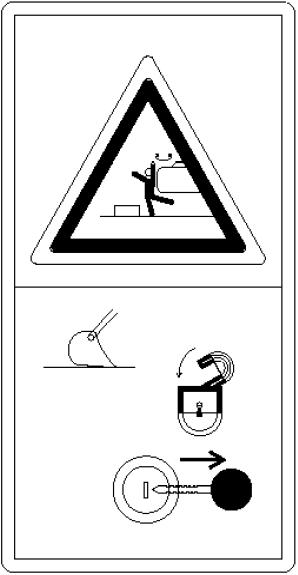

1. The sign says that the there is the risk of being clamped or run over by the machine if the machine suddenly moves.
2. Before leaving the machine, lower the working device to the ground, and move the locking lever to the locked position and then remove the engine key.
(19) Precautions for operation, inspection, transportation and maintenance, as shown in Figure 1-20.
Attention
1. Warning
2. Read the manual carefully before operation, maintenance, dismantle, assembling and transport.
(20) Drop warning, as shown in Figure 1-21.
Warning
1. The sign indicates falling danger.
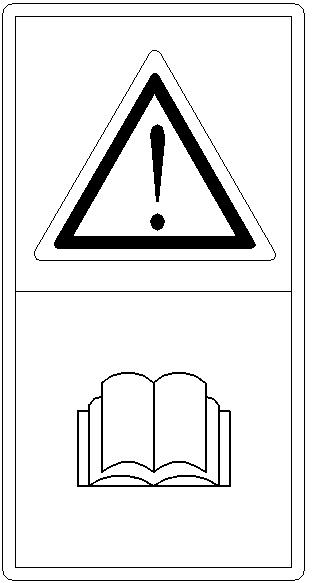
2. Keep away from it for a certain distance.
(21).Prohibit from hot-wiring machines, as shown in figure 1-22.
Danger
1. It is allowed to start the engine only when the operator was sitting on the seat.
2. Do not start hot-wire the machine, otherwise it will cause serious injuries or fire accidents.

(22) Sign for Maintenance of the air filter, as shown in Figure 1-23
● Please don’t add oil to the air filter.
● Clear the filter element of outer cylinder every 250 hours (or three months), or when the jam indicator light is on.
● After the filter element of outer cylinder is cleared, if there is alarm of air filter, exhaust color gets bad, or the machine does not work well, please replace filter elements of outer and inner cylinders. In addition, do not clean the filter element of the inner cylinder.
● Replace the filter elements of outer and inner cylinders after the filter element of outer cylinder has been cleaned for 5 times or replace them every one year.
● Avoid collision of the filter element and avoid splashing oil on it, if it is damaged, please replace it.
● Refer to the instruction for the cleaning and replacement of filter element
(23) Drop warning, as shown in Figure

1. The sign says that there is falling danger.
2. Don’t stand close to this place.
(24) Stop spinning while detecting and adjusting, as shown in Figure 1-25
1. The sign says that there is danger at the slewing parts, such as belts.
2. Contact the machine only when all parts of the machine have been stopped safely.

(25) Description of the use of emergency exits, as shown in Figure 1-26.


Prompt
The sign indicates to take out the breaker hammer to break glass on the back window and escape from the back window, mind being hurt by the broken glass.
(26) Warning for closing the window, as shown in Figure 1-27.

Prompt
1. The sign shows that the window may fall off.
2. Plug in the safety lock device after the window is lift up.
(27) Precautions when cutting off the negative power supply switching, as shown in Figure 1-28
Attention
Please cut off the negative switch when the machine is parked for long time.
Attention
Please cut off the negative switch when the machine is parked for long time
Precautions when turning off the negative power supply
(28) Precautions on the high-temperature coolant and hydraulic oil, as shown in Figure 1-29.
Warning
1. It shows the risk of injury by emitted hot oil or hot water when opening the cover of radiator or the hydraulic tank at high temperatures.
2. Let the radiator and hydraulic tank cool down before removing the cover.
(29) Precautions on using the accumulator, as shown in Figure 1-30
Attention
1. The sign says that there is a risk of explosion.
2. Drilling, cutting, impact or decomposition are prohibited in the accumulator, keep the accumulator away from open flame.
(30) Prohibit from entering the slewing range and away from the
Prompt
1. The sign says that there is risk of crashing hazard by machine superstructure.
2. Keep away from the slewing area of the machine at a safe distance.

1.2Safety instruction

1.2.1 Basic safety requirements
a) According to the local laws and regulations at the place where the user of the machine is in, the driver should obtain required driver's license or training completion certificate, only after the training and guidance, can the personnel operate the machine.
b) While operating the machine operation comply with all safety rules, precautions, and instructions for use.
c) If the driver is under the influence of alcohol or drugs, his ability of safe operation or repair of the machine will be severely weakened, and he as well as the presence of others will be in danger.
d) When working together with other operators or site traffic control personnel, must make sure everyone understand the hand signals.
1.2.2 Safety at work site
Before you begin operation, a thorough check is necessary for the work area to find any abnormality (Figure 1-32 below): a) Be careful when working near such combustible materials as thatched roof, dry leaves or hay to prevent fire disasters b) Check the terrain and conditions of the working ground, and determine the safest method of operation. Do not operate at places where there are landslides or rock fall hazards. c) If there are buried pipes, trachea, or high-voltage wires at the workplace under the ground of the work site, please contact the utility companies and map their location, so as not to damage any pipeline. d)Adopt the necessary measures to prevent any unauthorized access to the work area. e) Before traveling or operating in shallow water or soft ground, right before the operation, please check the type and circumstances of the bedrock as well as the water depth and flow rate.
1.2.3 Safety at work
If any abnormalities (noise, vibration, odor, incorrect instrument display, tobacco, oil leaks, or any unusual display of the alarm device or instrument) are found during operation, you should report to the personnel in charge and take the necessary measures. Do not operate the machine until the failure is removed.
a) When the operator wants to stand up from the seat to open or close the window, remove or install the bottom window, or adjust the seat, completely lower the working device down to the ground and lock the locking lever before turning off the engine. If you accidentally touch the unlocked lever, the machine will suddenly move, which may cause serious injury or damage to the machine.
b) When leaving the machine, be sure to completely lower the working device down to the ground and lock the locking lever before turning off the engine. Lock all equipments, remove the key and put it on the specified location, as shown in Figure 1-33.
1.2.5 Keep the machine clean
a) If water enters the electrical system, it may result in failure or malfunction. Do not use water or steam to flush the electrical system (sensors and connectors, etc.).
b) If inspection and maintenance is done when there is mud or greasy dirt on the machine, there will be risk of slipping, or dirt may enter the eyes Therefore, the machine should always be kept clean, as shown in Figure 1-34

1.2.6 Keep the cab clean
a) When entering the cab, be sure to remove the mud and oil on the soles. Pedal operation with mud or oil sticking under the soles may lead to serious accidents due to foot slipping.
b) Do not leave any parts or tools around the cab.
c) Do not stick the suction pad to the glass. Suction pad works as a magnifying glass, which may cause a fire disaster d) Do not use mobile phones in the cab while driving or operating the machine. e) Do not put dangerous goods such as flammable and explosive materials into the cab.
1.2.7Avoid scalding injury
1.2.7.1 Hot cooling liquid
When checking or discharging the coolant, operation should not be started until water cools down to the temperature that the radiator cap can be touched with hands in order to prevent burns caused by the spray of hot water or steam. Even if the coolant has cooled down, pay attention to release the cover slowly before removing the radiator cap, so as to discharge the internal pressure of the radiator.
1.2.7.2 Hot oil
When checking or discharging the oil, operation should not be started until the oil cools down to the temperature that the cap or screw plug can be touched with hands to prevent burns caused by the spray of oil or hot parts. Even if the oil has cooled, please pay attention to release the cover or plug slowly before removing them, so as to drain the pressure inside.
1.2.8 Fire and explosion
1.2.8.1 The prevention of fire caused by fuel or oil
Fuel, oil, antifreeze and window washing liquid are all flammable and dangerous. To prevent fire, be sure to comply with the following provisions: a) Do not smoke or use any open flame near fuel or oil (as shown in Figure 1-35). b) Turn off the engine before refueling. c) Do not leave the machine when adding fuel and oil. d) Tighten the fuel and oil tank cap firmly. e) Do not let fuel overflow to the overheating surface or parts of electrical system. f) Refuel or store the oil in a well-ventilated place. g) Oil or fuel should be stored in designated places, when people are not permitted in without permission. h) Wipe spilled fuel or oil after fuel or oil is added. i) When grinding or welding operations are carried out on the lower part of machine, all combustible materials should be moved to a safe place before work starts. j) Oil used to wash the parts should be non-flammable oil. Diesel and petrol ignite easily, so do not use them. k) Put oil-stained cloth or other combustible materials into a safe container to ensure a safe workplace. l) Do not solder or cut the piping which contains flammable liquids.

1.2.8.2 Prevention of fires caused by piles of combustible materials
Remove the dried leaves, wood chips, paper, dust and other combustibles that are piled up or stick to the engine, exhaust manifold, muffler, around the battery or interior of the hood.
1.2.8.3 Prevention of fires caused by the electric wire
Short-circuit of the electrical system can cause a fire, thus it is required to: a) Keep the wire connectors clean and firmly fixed. b) Check daily whether the wires are loose or damaged, tighten the loose connectors or wire clamps, repair or replace the damaged wires.
1.2.8.4 Prevention of fires caused by hydraulic pipelines
Check whether all clamps, shield and cushion of the hose and tube are firmly in place.
In case there is a loose part, it will vibrate and rub against other parts during the operation, causing damage to hose and spraying of high pressure oil, which may result in fire hazards or serious injury.
1.2.8.5 Prevention of explosion caused by the lighting
a) Use explosion-proof performance lighting while checking the fuel, oil, battery electrolyte, window washing fluid or coolant, otherwise, there will be risk of serious injury caused by an explosion .
b) When using the power of the machine is used for lighting, follow the provisions of this manual.
1.2.8.6 Accumulator
1.2.8.6.1 Precautions for operating accumulator
The accumulator is filled with high pressure nitrogen, so careless operation may cause explosion, resulting in serious injury or damage. Therefore, operators must observe the following precautions (see Figure 1-36): a) Can not disassemble the accumulator. b) Do not place accumulator near the fire source or expose it to the flame. c) Do not drill or weld the accumulator or use soldering set on it. d) Do not hit or roll the accumulator; prohibit the accumulator from being impacted in any way. e) The accumulator must be deflated before disposing of

1.2.8.6.2 Pressure relief steps for control pipelines of machine equipped with accumulator
a) Lower the working device to the ground, and then turn off the breaker or other accessories.
b) Turn off the engine.
c) Turn the starter switch key to the ON position, so that the current flows in the circuit.
d) Put the safety locking lever to the free position, and then fully operate the control lever to the front, rear, left and right position and the accessories control pedal to release the pressure in the control pipeline e) Put the safety locking lever to the locked position to lock the control lever and accessories control pedal.
1.2.8.7 Batteries
1.2.8.7.1 Battery installation and removal
Battery installation and removal should be done according to the following: a) When installing or removing the battery, be sure to confirm the positive terminal (+) and the negative terminal (-) first. b) Battery self-discharge is caused by the dirt around the terminals. Polish the terminal with sandpaper to remove the dirt, and coat it with a thin layer of lubricant before installation. c). For installation, the first step is to install the positive (+) terminal. Please be particularly careful for there will be risk of sparking if tool touches the positive terminal and the rack, finally connect the grounding terminal Check if the battery is loose after being installed in place. If movable, it should be reinstalled. d) The battery should be removed as reverse sequence as installation, viz. to remove the battery, start with removing the ground side (negative (-) terminal) (see Figure 1-37).
When installing,first connect the cable to + When disassembling,first disconnect the cable of the grounding terminal
Precautions for removing and installing batteries
e) Clip the battery firmly with battery clips while replacing.
f). Tightening torque for installing the battery is 9.8 ~ 14.7 N • m.
1.2.8.7.2 Battery charge
When the battery is charging, wrong operation may cause the risk of battery explosion (Figure 1-38). Therefore, the charge of battery must follow the instructions in the “Common Faults and Solutions” and instruction manual along with the charger, besides, please observe the following precautions: a) Adjust the voltage of the charger to a match the voltage of the rechargeable battery. If the voltage selected is not correct, the charger may overheat and cause an explosion. b) Connect the positive (+) clamp of the charger to the positive (+) terminal of the battery. And then connect the negative (-) clamp of the charger to the negative (-) terminal of the battery. Make sure that the clamps are fixed. c) Adjust the charge current to 1/10 of the rated battery capacity, for fast charge, the charge current should be lower than the rated battery capacity. If the charging current is too high, the electrolyte will leak or evaporate and the battery will catch fire or explode. d) If the battery electrolyte is frozen, do not charge the battery or start the engine with different power supply. Otherwise, the operation will light the battery electrolyte and cause battery explosion. e) If the battery electrolyte level is below the lowest line, do not use the battery or charge the battery, because this will cause an explosion. Check the battery electrolyte level regularly and add distilled water to keep the electrolyte level at the upper line.

1.2.8.7.3 Prevention of danger caused by the battery
Figure 1-39 Precautions for using the battery Figure 1-40 Precautions for removing the battery
As the battery electrolyte contains sulfuric acid and produces flammable and explosive hydrogen, any wrong operation may result in serious injury or fire disaster. So be sure to observe the following precautions (as shown in Figure 1-39): a) While handling the battery, wear safety goggles and rubber gloves. b) Smoking or open flame are not allowed near the battery. c) If sulfuric acid splashes to clothes or skin, immediately flush with plenty of water. d) If the sulfuric acid enters into the eyes, rinse immediately with plenty of water and seek medical care immediately. e) Before operating the battery, starter key must be switched to OFF position.
Because of the danger of sparks, please do according to the following steps (as shown in Figure 1-40): a) Do not let tools or other metal objects in contact between the battery terminals, do not drop any tools or other metal objects near the battery. b) When removing the battery, you should first disconnect the negative (-) terminal (grounding terminal); When the battery is installed, it is necessary to first connect the positive (+) terminal, and connect the grounding terminal lastly. Battery terminals should be firmly fixed. c) The charging of the battery produces flammable hydrogen gas, so you should remove the battery from the lower part of the machine before charging, and put it into a well-ventilated place and remove the battery cover. d) Firmly tighten the battery cover. e) The battery should be firmly mounted to the determined position.

1.2.9 Actions taken in the event of a fire disaster
Once a fire disaster takes place, obey the following requirements and immediately leave the machine: a) Turn the starter switch to OFF position to turn off the engine. b) Use handrails and ladder for self-help to leave the machine.
1.2.10 Prevention of falling objects, flying objects, and the invader
At such dangerous workplace where falling objects, flying objects and the invaders may hit or enter into the dangerous workplace of the cab, consider the operating conditions and install the necessary shield to protect the operator (as shown in Figure 1-41).

a) When conducting demolition or crushing operations, mount front cover should be equipped, and paste cellophane on the front glass.
b) While the machine is operating in the mine or quarry with rockfall danger, you should install FOPS (Falling Object Protections) and the front shield, and paste transparent cellophane at the front glass.
c) When conducting the above operations, the front windows should be closed. In addition, ensure that other personnel are outside the litter danger zone, and keep an appropriate safe distance.
The above-mentioned is the typical operating conditions, and other guards may also be needed to install according to the actual operating conditions of the construction site. Please contact Zoomlion or Zoomlion dealer in advance.
1.2.11 Keep away from the high-voltage cable
Do not drive or operate the machine in the vicinity of cables, otherwise it is easily to encounter an electric shock, which may result in serious injuries or accidents (see Figure 1-42). Comply with the following regulations when the workplace may be close to cables: a) Before starting work in the vicinity of cables, you should notify the local power company about the operations to be carried out and request them to take necessary measures. b) The operator may also encounter electric shocks even if he does not come close to the high voltage cable and suffer from serious burns or even death, so a safe distance must be maintained between the machine and the cable (see Table 1-1). Check the measures taken for safe operation with the local power company before operating the machine. c) In order to be prepared for accidents that may occur, wear rubber boots and rubber gloves. Cap the seats with a layer of rubber pad and pay attention not to let your exposed parts of your body touch the lower part of the machine body. d) If the machine and the cable are too close, you should have a signalman send a warning. e) When operating in the vicinity of high-voltage cable, do not let anyone get close to the machine. f) If the machine and the cable are too close or if the machine touches the cable, in order to prevent electric shock, operator should not leave the cab, so as to prevent electric shock.
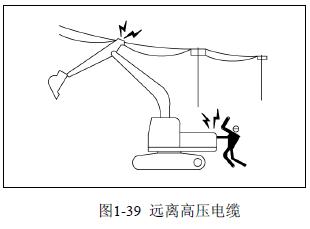
Table 1-1 The shortest safety distance from high and low voltage

1.2.12 Ensure a good vision
To ensure safe operation or traveling, you have to check whether there are people or obstacles in surrounding area of the machine and check the conditions of the workplace. Besides, obey the following requirements: a) Open the work lights and headlights mounted on the machine while operating in dark places; set auxiliary lighting in the working area if necessary. b) In case of poor vision, such as in condition of fog, snow, rain or dust, the operation should be stopped.
1.2.13 Ventilation of the closed region
If you have to start the engine, dispose of fuel or clean oil or paint in a closed area, open the doors and windows to ensure ventilation,so as to prevent gas poisoning.
1.2.14 Signals and gestures of signalman
a) Set a flag on road shoulder or soft ground. In case the vision is not good, arrange a signalman if necessary. The operator should pay particular attention to the signs and obey the command of the signalman.
b) Signals should be sent only by one signalman.
c) Before operation, ensure that all workers understand all the signals and gestures.
1.2.15 Prevention of asbestos dust hazard
Inhalation of asbestos dust in the air may cause lung cancer. There is danger of inhaling asbestos when operators are engaged in the operation of demolition or handling industrial waste in the workplace, (see Figure 1-43), so be sure to observe the following rules: a) For cleaning, spray some water for suppressing dust, and do not clean with the compressor air. b) If the air contains asbestos dust, operation of the machines must be done in windward side and all personnel should use qualified dust masks. c) During operation, do not allow other persons to get close. d) Comply with rules, regulations and environmental standards of the workplace
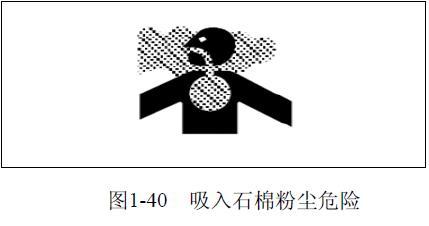

The parts of this machine use no asbestos, but the counterfeit parts may contain asbestos, so be sure to use standard Zoomlion parts.
1.2.16 Safety rules for hydraulic oil
There is always pressure in the hydraulic system. When checking or replacing the pipes or hoses, be sure to check whether the pressure within the hydraulic circuit has been released. If the oil is still under pressure, it can cause serious injuries or damages, so be sure to obey the following regulations: a) Do not carry out check or replacement when there is pressure in the hydraulic system. b) If there is any leakage at the pipe or hose or the Figure surrounding area is wet, you have to check there is pipe or hose crack or hose expansion. You have to wear goggles and leather gloves when doing the checks (see Figure 1-44). c) High pressure oil leaked from the holes will penetrate into the skin, and if it contacts with eyes, one may go blind. If skin or eyes are injured by the high-pressure oil flow, use a lot of clean water to rinse and seek medical care immediately.
1.2.17 Safe operation of the high pressure hose
If the high pressure hoses leak oil, fire disaster or operation failure will occur, which may result in serious injury or damage. If any bolts are found loose, operators should stop operation and tighten the bolts to the specified torque. If any damages are found in the hose, immediately stop operation and contact Zoomlion or Zoomlion dealer.
If you find the following questions, please replace the hose.
a) The hydraulic fittings are damaged or leaks.
b) Cladding is frayed or disconnected, or wire of strengthening layer is exposed.
c) Expansion appears at some parts of cladding.
d) The movable part is distorted or crushed.
e) There are impurities in cladding.
1.3 Unauthorized modification
Modification without Zoomlion’s permit would be dangerous. Before modification, you should contact Zoomlion or Zoomlion dealers. The Zoomlion will not be liable for any injuries, accidents or product failures caused by unauthorized modifications.
1.4 Safety tool
1.4.1 Work clothes and labor protection appliances
a) Do not wear loose clothes and jewelry, for they may snag on the levers or other protruding parts.
b) Long hair falling out from helmet may be wrapped into the machine, so long hair should be tied to avoid danger.

c) Always wear a helmet and safety shoes (Figure 1-45). In the operation or maintenance of the machine, the operators should wear safety goggles, face shields, gloves, ear plugs and belts if required.
d) Check whether all protective devices are working properly before use.
1.4.2 Fire extinguisher
The following precautions must be observed in the event of injury or fire disaster (see Figure 1-46): a) Ensure that a fire extinguisher is ready for use and there are labels showing how to use the in case of emergency. b) Carry out regular inspection and maintenance to ensure that fire extinguishers can be used at any time. c) Make record of emergency contact numbers of the operator.

1.4.3 Handrails and pedals
In order to prevent personal injury resulting from slipping or falling from the machine, please obey the following requirements: a) When getting on or off the machine, please use the handrails, stairs and track shoe support marked by the arrows in Figure 1-47 b) To ensure safety, you should face the machine and maintain the three points (two feet and a hand or two hands and one foot) on the handrails and the pedal (including crawler board), so as to support the body, as shown in Figure 1-48. c) When getting on and off the machine, do not grip the lever. d) Do not climb to the hood or lid without anti-skid pad on it. e) Check the handrails and pedals (including track shoe) before getting on and off the machine. If there is any oil, grease or mud on the handrails or pedal (including track shoe), they should be immediately wiped off to keep these parts clean. If damaged, these parts should be repaired and loose bolts should be tightened. f) Do not ascend or descend the machine with tools in hands.

1.4.4 Cab emergency exit
If for some reason, the cab door can not be opened, you can open the rear window and use it as an emergency exits.
Escape by the following steps (as shown in Figure 1-49):

1. Break the glass of the rear window with the hammer (1) hanging in upper right of the back of the cab
2. Climb out from the rear window.
The rear window should not be broken unless it is used as an emergency exit.. After smashing the glass, you should contact Zoomlion or Zoomlion dealer to replace the cracked glass as soon as possible.
ZE205E/ZE230E HYDRAULIC EXCAVATOR OPERATION MANUAL
Chapter Two: Product overview
2.1 Introduction
Chapter Two: Product overview
Zoomlion hydraulic excavators mainly serve the purpose of digging, leveling, trenching, loading and demolition operations, and the specific scope of operations is as follows:
2.1.1 Use of excavator
(1) Digging operation
Backhoe is suitable for digging at a position lower than the machine.
When the machine is in the state shown in Figure 2-1, that is, the maximum digging force of each cylinder is achieved when the bucket cylinder and bucket as well as bucket arm cylinder and bucket arm are of an angle of 90. Efficient use of digging at this angle optimizes work efficiency. Excavation scope is from 45 °angle away from the machine to 30 °angle towards the machine. Digging depth may be different, but try to operate within the above range rather than fully extend the cylinder
(2) Trenching operation
Install a bucket that is suitable for the trench and then adjust the crawler to a position parallel to the trench to begin trenching operation, as shown in Figure 2-2.


When digging a wide trench, dig from both sides and then the central part.
(3)
Loading operations
At places where the rotation angle is small, park the dump truck in the place that is easy to see by the operator can operate for more effective operation. Loading from the rear of the dump truck is more convenient than that from the both sides, and is of larger loading capacity. The loading operation is shown in Figure 2-3
In addition to the above-mentioned uses, more can be achieved through the use of a variety of accessories and optional parts.
2.1.2 The direction of the excavator
The front, back, left and right directions mentioned in this manual (see Figure 2-4) refer to the direction of traveling that the driver see when he faces forward and the drive sprocket is at the rear of the machine

2.2 External view of the excavator
The ZE205E and ZE230E hydraulic excavators introduced in this manual are basically of the same shape, as shown in Figure 2-5
2.3 Main technical parameters of the excavator
The comparison of the main technical parameters of ZE205E and ZE230E are shown in Table 2-1, the external dimensions are shown in Figure 2-6, and the scope of work of the two models is shown in Figure 2-7 and 2-8.
